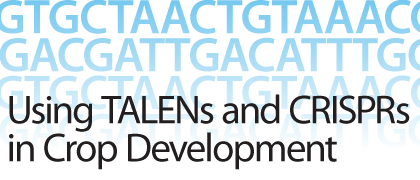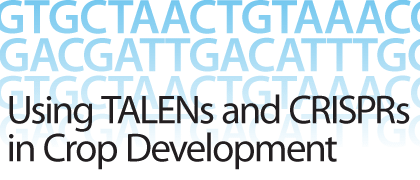
Recently developed new breeding technologies could mean a number of new traits moving into improved crops faster, easier and more economically.
Plant breeders and researchers are excited about TALENs and CRISPR/Cas-based systems — short for transcription activator-like effector nucleases and clustered regulatory interspaced short palindromic repeats, respectively — and what they may bring to bear on crop improvement and development.
“There’s a lot of intense interest right now in the community of individuals who investigate and develop improved crops and animals about the use of these technologies,” says Jeff Wolt, professor of agronomy for the Biosafety Institute for Genetically Modified Agricultural Products at Iowa State University.
Among these new breeding technologies are a group of diverse techniques that allow for very specific — or site-directed — modification of plant and animal genomes using natural processes of the cell.
Researchers use these techniques, also known as genome editing, to target a specific gene of interest. They then disable, or knock out, that gene to study the resulting phenotype (physical or biochemical manifestation of the gene) after the mutation has been performed. Observation of the plant’s phenotype provides information about gene function. For example, a specific gene is targeted and, in the simplest instance — known as nonhomologous end-joining — a point deletion and repair is performed, which is frequently error prone and causes a mutation of that gene. In some cases, the mutation may result in a beneficial new trait.
Jeff Wolt is a professor of agronomy for the Biosafety Institute for Genetically Modified Agricultural Products at Iowa State University.
“The fundamental work at the front end of identifying gene function allows us to target specific genes for modification,” says Wolt. “The fact that we’re able to do very specific gene modifications means we’re going to get some traits that are going to be attractive … [and] can be moved quickly into improved crops. I think a host of new traits are going to be available.”
Changes to a specific location within the genome can be affected in different ways. The nuclease systems can cause a double-stranded breakage in the DNA and the typical nonhomologous repair mechanisms will take effect. Errors are often incorporated into the genome at the time of repair. The errors are the mutations of interest in terms of how they alter the functioning — or phenotype — of the plant, explains Wolt. These same nuclease systems can also cause breaks that will be repaired by the process of homologous recombination, which allows the insertion of foreign DNA resulting in transgenic plants.
However, most of the interest is being directed to the study of mutations created by the nonhomologous repair mechanisms after inducing breakages. Once genes of interest are identified and if certain site-specific mutations provide utility, the genes can be moved into plants improving varieties easily and specifically, says Wolt.
In fact, it is the combination of ease of use and specificity that is generating buzz among scientists.
“These tools offer special opportunity in that they are exceedingly specific and appear to be very easy to use as well,” says Wolt. “They are amenable to high-throughput-type developments where we can look at them rapidly and in great detail. There are many promising [aspects] about them that we haven’t seen heretofore in some of the innovative techniques that have been used.”
“Time to market, the cost of regulation and ease of use … suggest [these new breeding technologies] are going to be attractive from an economic standpoint.” — Jeff Wolt
These genome-editing nucleases are essentially mechanisms that carry information to a specific site within a genome. Through bioengineering, that information can be modified to indicate the specific site of interest within the genome and make changes to the gene at that site only. “The high specificity is really what’s of interest to people. If they’re highly specific, you don’t have any unintended changes … and you don’t have as many issues around unintended occurrences which might have implications for the behavior of the phenotype, both from an efficacy as well as a safety standpoint,” says Wolt.
While the products of some related technologies, such as RNA interference and the use of zinc-finger nucleases, are well down the development pipeline and are currently being evaluated by regulators, the first published example of an improved crop using TALEN-based genome editing appeared last year. The study, led by Bing Yang, an associate professor in the department of genetics, development and cell biology at ISU, reported the development of disease-resistant rice in Nature Biotechnology in May 2012.
According to the study, researchers used TALEN technology to “edit a specific S gene in rice to thwart the virulence strategy of [Xanthomonas] ogyzae and thereby engineer heritable genome modifications for resistance to bacterial blight.”
“Bing used TALENs to target that particular gene and to do a simple deletion and repair. Out of that, he was able to select plants that were modified but did not carry any genetic elements other than the plants’ own genetic elements. He then moved those further into development,” says Wolt, adding that the researcher created a null-segregant — in which progeny lack any transgenic material — selected from the transformations he performed, resulting in the development of disease-resistant rice.
Kits are currently available to researchers or developers to perform plant transformations with TALENs. Although the development of CRISPRs is more recent, the technology is rapidly moving into labs. “From what I’ve read, the use of CRISPRs is even simpler than the use of TALENs. They will be in the hands of biotechnologists very quickly. There certainly have been successful transformations made on crop plants already, says Wolt.
Widespread adoption of these new breeding technologies may come down to economics. One of the avenues of research at ISU and its newly formed Crop Bioengineering Consortium is to address the economics of the new breeding technologies and whether or not they are more cost-effective than other current alternatives.
“The feeling is they’re going to be much more economical,” says Wolt. “They’re going to allow you to move materials through a development pipeline more quickly.… Additionally, there is this hope, or belief, that we’re going to have a reduced regulatory burden and that would cut down on costs as well. Time to market, the cost of regulation and ease of use, these three things suggest [these new breeding technologies] are going to be attractive from an economic standpoint,” says Wolt, adding a cost analysis has not yet been performed.
It may be too soon for definitive statements about the regulatory environment surrounding these new technologies, but Wolt believes the regulatory burden may be reduced. “For most countries in the world, if you’ve used mutagenesis to obtain modifications of the plant for improved traits the regulatory requirements are minimal. That means a very low hurdle compared with genetically engineered crops, where we’ve seen systems in various parts of the world buckle under the questions that are asked and an inability for policies to move the technology forward. There is a unique opportunity [for these new technologies] perhaps,” says Wolt.
“Canada has a somewhat different approach to regulation where the focus is on the trait regardless of the means used to create the trait…. The technique, the specificity of it and the understanding that is emerging probably means plants derived using these genome editing tools will be dealt with very efficiently within the Canadian system.”
“Plants derived using these genome editing tools will be dealt with very efficiently within the Canadian system.” — Jeff Wolt
One other factor affecting adoption of these technologies is intellectual property rights of the techniques and whether or not they will be available to the developer community.
“It appears there are some real attractive opportunities here. As far as we understand, there is ready access to affordable licenses for TALENs — they’re not restricted and they’re supposed to be intended to be used widely,” says Wolt, adding that in general CRISPR technology is also accessible to the user community.
The specificity, ease of use, cost-effectiveness, ready access and possible reduced regulatory burden make these new breeding technologies an appealing package for plant breeding and trait development communities.
“The technologies are intrinsically very attractive. They work very well, they’re moving along very quickly, but their utility long term for crop improvement is going to depend on these externalities — what will be the regulatory view, how will governments throughout the world support the technology in terms of funding research and aiding in public communication, how will the intellectual property landscape evolve, and the economics — these are the things that people are trying to get their arms around right now,” says Wolt.
Kari Belanger













